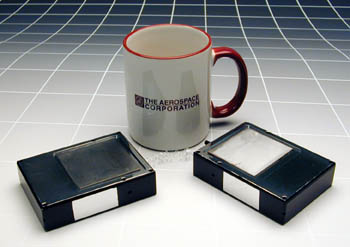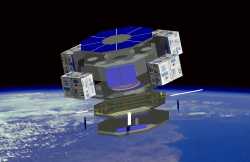MicroSatellites
Tiny Satellite Constellations to Debut in November Launch
10/11/99 -- A mission scheduled to be launched in late November from Vandenberg Air
Force Base, Calif., will give a preview of how tiny satellites would operate in
constellations.
The mission will usher in a spaceflight program to validate MEMS -- tiny
microelectromechanical systems being developed under sponsorship of DARPA, the Defense
Advanced Research Projects Agency.
The experiment calls for two tethered picosatellites, each weighing less than
one-half-pound and not much larger than a deck of cards, to be released into low Earth
orbit by the OPAL satellite. OPAL is the Orbiting Picosat Automated Launcher built by
Stanford University students at the school's Space Systems Development Laboratory.

Picosatellites, less than one-half pound each, are shown against
a coffee mug. (The Aerospace Corp.)
Scientists and engineers at The Aerospace Corporation, El Segundo, Calif.,
conceived the picosat mission, designed the tiny satellites, integrated and tested the
components, and delivered the picosats ready for flight. They also are responsible for
flight operations.
Although the basic mission of picosats is to serve as a platform for testing miniature
devices such as MEMS, they also serve as a link to nanosatellites, slightly larger than
picosats and envisioned as tiny workhorses of the future.
First-Ever Demonstration
The mission is to be the first-ever to demonstrate the principles of miniature
satellites released from a "mother ship" flying in concert and communicating via
a local network as nanosatellites would.
The experiment, a joint project of DARPA and The Aerospace Corporation, is to be
launched aboard a new Air Force booster for small satellites -- the Orbital/Suborbital
Program Space Launch Vehicle.
Data Hopping
The orbiting picosats will perform "data-hopping" communications with a
stationary third picosat on the horn of a ground antenna operated by SRI International at
Menlo Park, Calif.
Commands to the picosats will be issued from the ground station. Tasks, in addition to
communicating with each other, will include operating an array of experimental radio
frequency MEMS switches designed by Rockwell Science Center of Thousand Oaks, Calif.

Artist's
rendering of tethered picosats in orbit. (The Aerospace Corp.)
Communication will be accomplished by chip-based digital cordless telephone technology
provided by Rockwell. The radios are derived from the DARPA-sponsored Low-Power Wireless
Integrated Microsensors program at UCLA and Rockwell.
Powered by lithium thionyl chloride batteries, the diminutive spacecraft will send
"data packets" to the ground station to report on the radio frequency switches
and the general health and status of the mission.
Revolutionary Systems
The switches, to be test-operated in space over a mission of several days, are one of
several technology programs that promise to revolutionize future communications systems by
offering low power, robustness, radiation tolerance and low unit cost via mass production
within the silicon microelectronics industry infrastructure.
A successful demonstration of the picosat mission will have significant implications
for future space-based defense technology, said William "Bill" C. Tang, Ph.D.,
MEMS program manager at DARPA.
Distinguished Engineer Ernest Y. Robinson of The Aerospace Corporation's Center for
Microtechnology said the picosat mission -- and another scheduled for early 2000 aboard
the Air Force Research Laboratory's MightySat 2.1 spacecraft -- will "set the stage
for future, fully functional nanosatellite orbital systems."

Picosat sensor board in casing. (The Aerospace Corp.)
Robinson and other researchers at the Center for Microtechnology believe nanosatellites
of 1 to 10 kilograms can be operational within five to ten years, offering efficient,
flexible and low-cost alternatives to contemporary large space systems as well as new
paradigms for space missions.
For military applications, Robinson said a swarm of miniature satellites could
communicate with microsensors on a battlefield and convey important surveillance and
tactical information, among other missions.
BACKGROUND
The picosat launch will take place from the Spaceport Systems International (SSI)
Commercial Spaceport at Vandenberg. It is to be the inaugural launch of the
Orbital/Suborbital Program Space Launch Vehicle developed by the Air Force Space and
Missile System Center's Test and Evaluation Directorate at Kirtland Air Force Base. It
also is to be the first launch from the commercial spaceport.
Orbital Sciences Corporation is handling launch integration for the Orbital/Suborbital
Program, whose purpose is to achieve low-cost spacelift for small satellites. The program
uses surplus Minuteman II solid rocket motors and upper stages derived from Orbital's
Pegasus rockets.
Satellite Classifications
Satellites are classified according to weight. Picosats are under one kilogram (2.2
pounds equal a kilogram), while nanosatellites range from 1 to 10 kilograms. Other classes
are microsats, 10 to 100 kilograms; small sats, 100 to 1,000 kilograms; and standard
satellites, 1,000 kilograms or more. The smallest category envisioned is the femtosat,
less than one-tenth of a kilogram, a satellite that would handle very simple missions.
Tethering

The two orbiting picosats are to be tethered because they will communicate via
micropower radios. The tether will keep them within range of each other for crosslink
purposes. In addition, the tether contains thin strands of gold wire to facilitate radar
tracking by U.S. Space Command. Concepts for the future involve optical communication via
fiberoptic tethers and other cluster architectures for miniature satellites for which
experience with tethers is useful.
Testing MEMS
The mission represents one of several programs for systematic testing and use of MEMS
in space to be designed and implemented by The Aerospace Corporation.
In another program, Aerospace researchers and colleagues at other organizations are
analyzing data from MEMS devices brought back from the space shuttle Columbia July 27 and
are making plans for a MEMS mission to the International Space Station.
Nanosatellites
The picosat mission is helping to lay the groundwork for nanosatellite missions. Mass
production using semiconductor technology and incorporating high-level building blocks
called application-specific integrated microinstruments, or ASIMs, a description coined by
Robinson, would characterize nanosatellite architecture and assembly.
ASIMs comprise MEMS and related electronics subsystems used to form standalone
capabilities. They can be integrated to create various types of ultrasmall instruments,
components and subsystems and -- ultimately -- complete systems and miniature satellites.
"The use of this technology for low-cost, reliable, integrated space systems
applications is inevitable," Robinson said.
Future space architectures include cooperative constellations, sparse aperture
antennas, local swarms of nanosatellites, inspection and service missions, and extremely
flexible launch-on-demand options, which include gun and balloon-assisted launches.
Concepts of The Aerospace Corporation
The radical new concepts for building and using spacecraft represented by the
nanosatellite concept were developed at The Aerospace Corporation and formally introduced
in a paper, "The Concept of 'Nanosatellite' for Revolutionary Low Cost Space
Systems," presented at the 44th International Astronautical Federation Congress in
Graz, Austria, in 1993.
Authors included Robinson, Siegfried Janson, Ph.D., -- who coined the term
nanosatellite and originated the concept -- and Henry Helvajian, Ph.D., a senior scientist
in the microtechnology center and editor of the just-published book,
"Microengineering Aerospace Systems."
A series of reports written by Helvejian, Janson, and Robinson and issued after the
1993 conference presented the details on how to design, build, power and maneuver
nanosatellites.
The nanosatellite technologies are now being explored by a number of national and
international research organizations in addition to The Aerospace Corporation.
Related Internet Sites
DARPA Microsystems Technology Office
-- http://www.darpa.mil/mto/
Orbiting Picosatellite Automated
Launcher -- http://ssdl.stanford.edu/opal/home.html
MEMS on Space Shuttle -- http://www.aero.org/news/
current/microthrusters.html
Micro/Nanotechnology Conference
-- http://www.aero.org/conferences/micro-nano/
Draper Laboratory -- http://www.draper.com/capabilities/mems.htm
|

